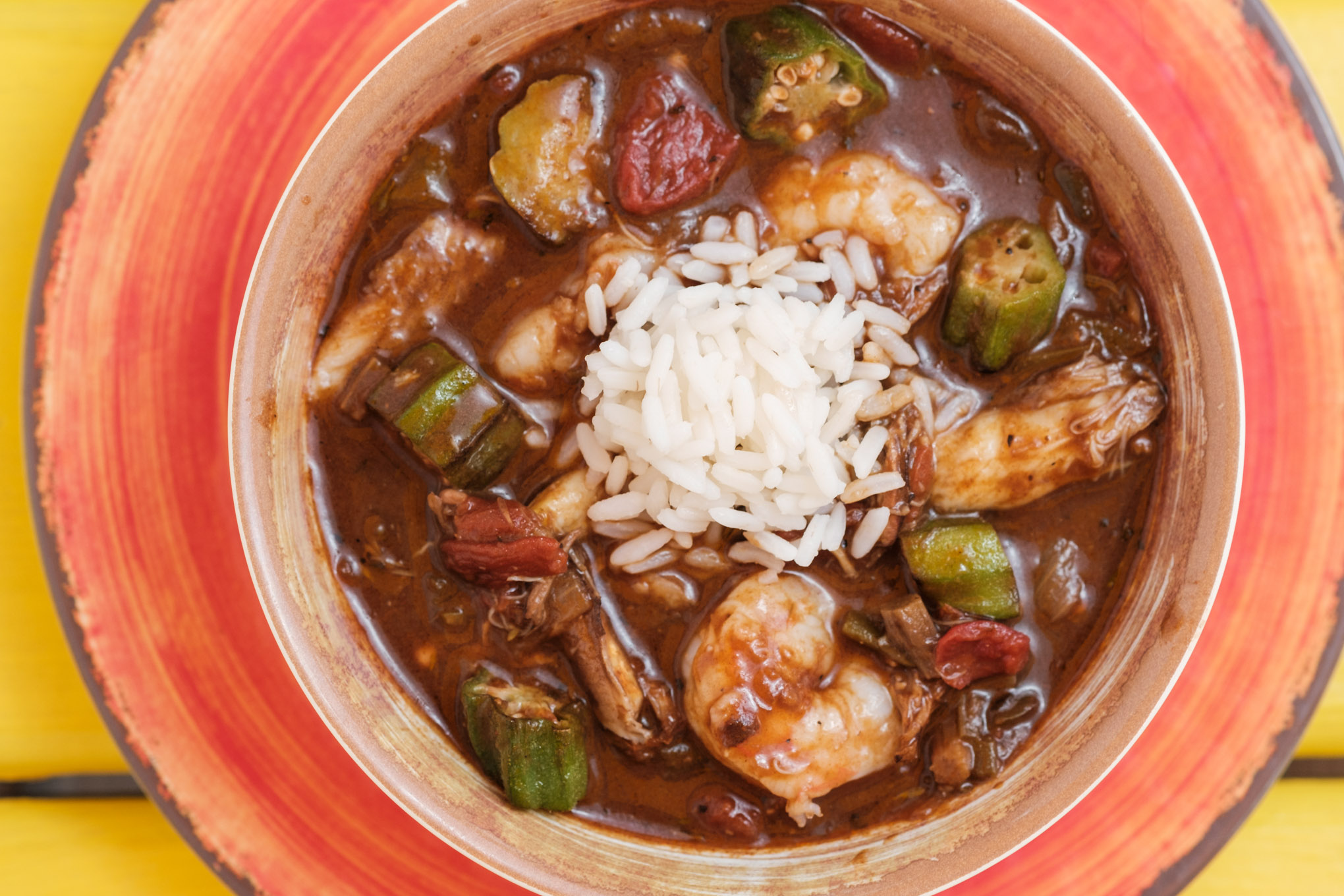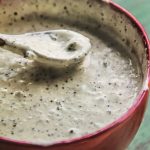
OVER THE YEARS, this is the recipe that I’ve cooked the most and that has remained a featured specialty at my restaurants. As far as the seafood goes, I use shrimp and crab, but if it’s cool enough for oysters and there are some sweet and pretty ones available, or it’s crawfish season, I will toss those in, too. And though I usually use only sausage in my winter gumbo, it’s no crime to add a little andouille to the pot as well.
14 – 16 servings
Ingredients
- 3 pounds medium wild-caught Gulf shrimp, heads on
- 2 pounds cooked blue crab claw meat, picked through for shells, handled carefully to keep the meat in big chunks
- 4 large ripe tomatoes, or 1 (28-ounce) can whole tomatoes with their juices
- ¾ cup vegetable oil or bacon grease
- 1 cup all-purpose flour
- 2 large onions, coarsely chopped
- 1 bunch celery, coarsely chopped, including leaves
- 2 green bell peppers, coarsely chopped
- 8 cups shrimp or seafood stock, heated
- 2 to 3 teaspoons sea salt, or to taste
- 1 tablespoon freshly ground black pepper
- ¼ teaspoon cayenne pepper
- 2 tablespoons dried thyme
- 4 bay leaves
- 1 teaspoon dried oregano
- 1 teaspoon dried basil
- 2 tablespoons LuLu’s Crazy Creola Seasoning or other Creole seasoning
- ¼ cup hot sauce
- 2 tablespoons Worcestershire sauce
- 4 blue crab bodies, if available (optional)
- 2½ pounds fresh okra, chopped into ¼-inch pieces, or thawed frozen cut okra
- 2 cups finely chopped green onions
- ½ cup finely chopped fresh parsley
- ½ cup fresh lemon juice
- Cooked white rice, for serving
- French bread and butter, for serving
Instructions
- Peel and devein the shrimp. (If you’re making your own stock, reserve the
heads and shells to make the stock.) Refrigerate the shrimp and crabmeat
until ready to use. - If using fresh tomatoes, fill a medium saucepan with water. Bring to a boil.
Carefully drop the tomatoes into the boiling water and cook for 1 minute.
Remove with a slotted spoon and let them cool. The skins will slip off easily.
Remove the cores and coarsely chop the tomatoes over a bowl to retain as
much juice as possible. Set aside. (If using canned tomatoes, chop each
tomato into eighths and return them to the juice in the can.) - To make the roux, in a large stockpot (about 10 quarts), heat the
vegetable oil over medium-high heat. When the oil is hot, gradually add the
flour, whisking continuously, and cook, stirring and adjusting the heat as
necessary to keep it from burning, until the roux is a dark mahogany color,
25 to 35 minutes. Be careful: if the roux burns, you will have to start all over
again! - Carefully add the onion to the roux and stir with a large wooden spoon for
2 to 3 minutes. (The onion will sizzle and steam when it hits the hot roux, so
caution is advised. All seasoned gumbo cooks have roux battle scars on one
or both arms.) - Add the celery and cook, stirring continuously, for 2 to 3 minutes.
- Add the bell pepper and cook, stirring continuously, for 2 to 3 minutes
more. The mixture should resemble a pot of black beans in color and texture. - Add the heated stock and the tomatoes with their juices. Stir in the salt,
black pepper, cayenne, thyme, bay leaves, oregano, basil, Creole seasoning, hot sauce, and Worcestershire sauce. Stir well. Bring the gumbo to a boil and
cook for 5 minutes, then reduce the heat to maintain a slow simmer. Add the
crab bodies (if using) and simmer, uncovered, for about 1 hour. - Add the okra and bring the gumbo to a boil. Cook for 5 minutes. Reduce
the heat to maintain a slow simmer and cook, uncovered, for 30 minutes, or
until the okra has lost its bright green color and cooked down like the other
vegetables. If the gumbo gets too thick, add a little water. If it is too thin,
continue to simmer it, uncovered. - Gumbo is always better the day after it has been cooked, although I’ve
never had a complaint when I served it the day I made it. At this point, you
can cool the gumbo. Turn off the heat and let it sit for about 30 minutes.
Then place the pot, uncovered, in an empty sink. Fill the sink with cold water
and ice around the stockpot (try not to get any in the stockpot itself). Stir
every 15 minutes to facilitate cooling. (The gumbo will spoil if improperly
cooled—see page xxx for tips on cooling the gumbo.) When completely cool,
refrigerate the gumbo in the stockpot, uncovered. - When ready to serve, slowly bring the gumbo to a simmer over mediumlow
heat. Thirty minutes before serving, add the green onion, parsley, and
lemon juice to the gumbo. Cover and cook for 15 minutes. Add the shrimp and
crabmeat, mix well, and cook for 2 minutes. Cover and turn off the heat. Let it
sit for at least 15 minutes more to cook the seafood. The gumbo will stay hot
for a long time. Remove and discard the bay leaves. Taste and adjust the
seasonings; serve over cooked white rice with French bread and butter.


